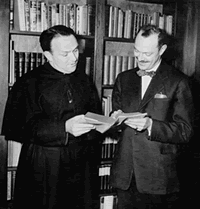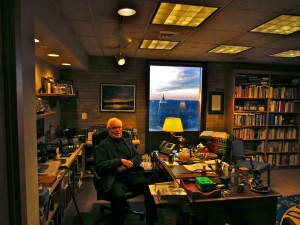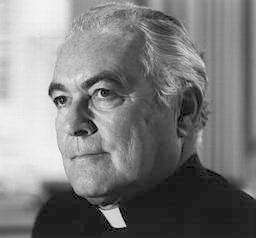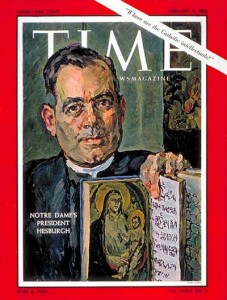My tentative thesis, or hypothesis, on Hesburgh’s life is that he seems to have been one of a rare breed in the so-called “Catholic Intellectual Tradition.” Namely, he seems to have lived out a balance between being a Catholic and a public intellectual. He was more than a university president, he was an intellectual.
This is clearly a compliment, but partially by way of contrast. That contrast rests on an acknowledgment of John Tracy Ellis
‘s contextual disparagement of midcentury Catholic intellectual life.** As a Catholic historian, historian of Catholicism, and a public intellectual, Ellis thought poorly of the general run of Catholics who had taken on intellectual roles in American history. In what follows I’ll elaborate on the typological distinction posited above, my first encounters with Hesburgh’s work, and my tentative evidence that Hesburgh achieved some kind of religio-intellectual balance. I’ll cover the first two today, and the last next week.
Typology
I define a religious intellectual as a self-identified religious person who displays the ability and willingness to bracket ideas, topics, theories, etc. It is a character trait that arises and is triangulated, or is confirmed historically, over time. To call it a character trait means that it repeats consistently such that it can be identified with one’s personality. Its habitual. The accent is on one’s identity as an intellectual.
But what does it mean to ‘bracket things’? I take this to be one’s ability to hold up a problem or issue and examine it from many different sides—including, especially, from sides that seem outside of one’s identity. The intellectual ability to bracket should display, I think, an element of surprise. There is something slightly Dionysian about that person’s thinking. That trait underscores the danger of the intellectual as a type. They might say, and then even do, something you hadn’t predicted. They can be enigmatic.
Even so, the religious intellectual will always, in the end, bring religion back into the conversation. She or he will judge and evaluate the results of their thinking against religious creeds, theologies, and tenets. At this point the religious intellectual may then close out a theory or conclusion if it strays into heresy or sin. But closure occurs after the consideration. The hallmark of the beginning of her or his inquiry is openness.
An ‘intellectually religious’ person—an intellectual Muslim, Protestant, or Catholic, for instance—is a self-identified religious person who starts with religious tenets, issues, or problems and then builds a thought structure, or structures, from that point. These structures can become quite elaborate and intricate. They might display a person’s intellectual prowess and the complexity of a religious issue. Those structures may even occasionally surprise people both inside and outside the thinker’s faith. But the person of faith who explores who reads the thinker’s writings and analyzes her or his actions know that they are on safe ground. Why? Because that intellectual actor starts with the cult’s premises and assumptions. They do so because the core of that thinker’s identity is linked to the religion from which they began their exploration. Other options are foreclosed from the start. The accent is on one’s religion.
Hesburgh is, I hypothesize, a ‘Catholic intellectual’ as opposed to an ‘intellectual Catholic’ because, at multiple points in his life as a public figure, he surprised his peers. I limit my speculations within the framework of hypothesis, however, because I have not fully explored the details of Hesburgh’s life. I haven’t visited the archives to review Hesburgh’s papers. I write as a Catholic and an intellectual historian with a strong interest in Catholic intellectuals. Even so, my historical thinking is based on non-archival sources (some primary and some secondary).
Hesburgh as an Early Great Books Liberal
My introduction to Hesburgh came first, of course, through the lens of “great bookies.” Catholic thinkers and institutions evidenced a fast affinity for putting the great books idea to use in higher education. This occurred, in part, because of Mortimer J. Adler’s strong and prominent links to Thomistic thought. Adler, in conjunction with Robert Maynard Hutchins, operated within Thomistic and Scholastic framework even as he professed philosophy, law, and psychology at the University of Chicago. Most famously, both Adler and Hutchins ran a “General Honors” course shaped around the great books idea. In that course they used Aquinas Summa Theologica (some portion), which was a radical for the 1930s in a non-Catholic university. The attention that Adler and Hutchins paid to the Catholic intellectual tradition gained them some notoriety with prominent Catholic thinkers. One of those was Hesburgh’s predecessor, John Cavanaugh.John J. Cavanaugh (1899-1979) served as Notre Dame’s president from 1946 until 1952. Under Cavanaugh’s leadership Notre Dame founded what would be known as Program of Liberal Studies (PLS) in 1950. First called the General Program, it unabashedly attached itself to—and grew out of—the larger Great Books Movement of the 1940s. At this point, in order help speed up the connection I want to make between Cavanaugh and Hesburgh, I’ll briefly turn the narrative over to Nicholas Ayo, CSC, who helped compose a history of PLS at Notre Dame:
Let us turn to the initial years of John Cavanaugh’s presidency. …Judge Roger Kiley came from Chicago to Notre Dame’s Law School for several years on a part-time basis to conduct Great Books seminars, which he himself had experienced through the Great Books Foundation in Chicago. It was hoped the [law] students would learn of natural law and of critical thinking, which would be encouraged by insightful group discussion. John Cavanaugh would lead with Kiley in seminar, following the pattern of St. John’s College in Annapolis. …At first only select law students were enrolled in the Kiley-Cavanaugh seminar, but eventually all first and second year law students required to take [them]. …The first Great Books program at Notre Dame was thus founded in the Law School during the presidency of John Cavanaugh. Theodore Hesburgh often took Cavanaugh’s place in the seminar in later years. When Hesburgh became president in 1952, he proved to be a patron and protector of Great Books education.
This connection is verified in the reflections of Otto Bird, a faculty founder of the program.

Otto Bird with Father John J. Cavanaugh, date unknown, from ND archives
In 1945, Kiley began to come to Notre Dame regularly to lead with Father Cavanaugh and Dean Clarence Manion a great books class with a select group of law students. …Father Cavanaugh become president…in 1946 and soon began preparing for the introduction of a Great Books program. …[After years of seminars involving Adler and Fr. T.J. Brennan,]…Father Cavanaugh…initiated the establishment of a Great Books program in the Arts College. …The General Program…remains distinctly different from other programs at Notre Dame. It still forms an intellectual community from its commitment to learning and teaching great books. …
During my years at Notre Dame, from which I retired in 1977, all but two were under the presidency of Father Hesburgh, who remained a strong supporter of the Great Books program.
At its inception in 1950 the Great Books program was the most “liberal” one in the university. It assigned books that were on the Index of Prohibited Books, for which permission had to be obtained from the president [i.e. Hesburgh]. Discussion seminars were held in which the students were encouraged to speak out and not just listen to their professors. The texts for study were great and difficult books, not just hashed down versions of them. All of this has now become standard practice throughout the university. But the Great Books program is also now considered one of the most “conservative” and reputedly the most Catholic. [p. 78,79, 95, 97]

Is it a coincidence that Hesburgh wanted his retirement office to be in ND’s library, which was also named after him?
We know from Una Cadegan’s recent excellent study, All Good Books are Catholic Books (Cornell, 2013), that the Church’s Index Librorum Prohibitorum was taken seriously by the Church hierarchy and its lay people through the 1950s.*** But Hesburgh and his supporters believed in the pursuit of scholarship such that older prohibitions had to reconfigured. The ideas in the books mattered more than their perceived adherence to Catholic doctrine. Hesburgh seems to have been a Great Books Liberal as I’ve schemed out that genre in my own work.**** In his historical context, he functioned as a Catholic intellectual rather than just an intellectual Catholic.
…
In next week’s post I will try to broaden and demonstrate Hesburgh’s status as a balanced Catholic intellectual and midcentury liberal through his work on the U.S. Commission on Civil Rights, his work on the 1967 Land O’ Lakes Conference and Statement, and Hesburgh’s support and friendship with President Jimmy Carter.
—————————————————
* The main outlines of Hesburgh’s life are available in last week’s obituaries. Here’s one: Anthony DePalma, “Rev. Theodore Hesburgh, Influential Ex-President of Notre Dame, Dies at 97,” The New York Times
, February 27, 2015.
** John Tracy Ellis, American Catholics and the Intellectual Life (Chicago: Heritage Foundation, Inc., 1956). As late as 1995, Thomas J. Shelley argued in America Magazine that Ellis’s arguments about the deficiencies of Catholic intellectual life still mattered.
***Hesburgh is not mentioned in Cadegan’s book, but he and Cavanaugh could have been used to support her argument about the liberalization of Catholic thought in relation to literature.
****Lacy, The Dream of a Democratic Culture: Mortimer J. Adler and the Great Books Idea (New York: Palgrave Macmillan, 2013).



0